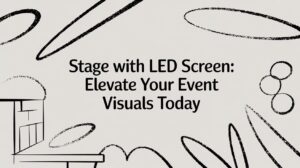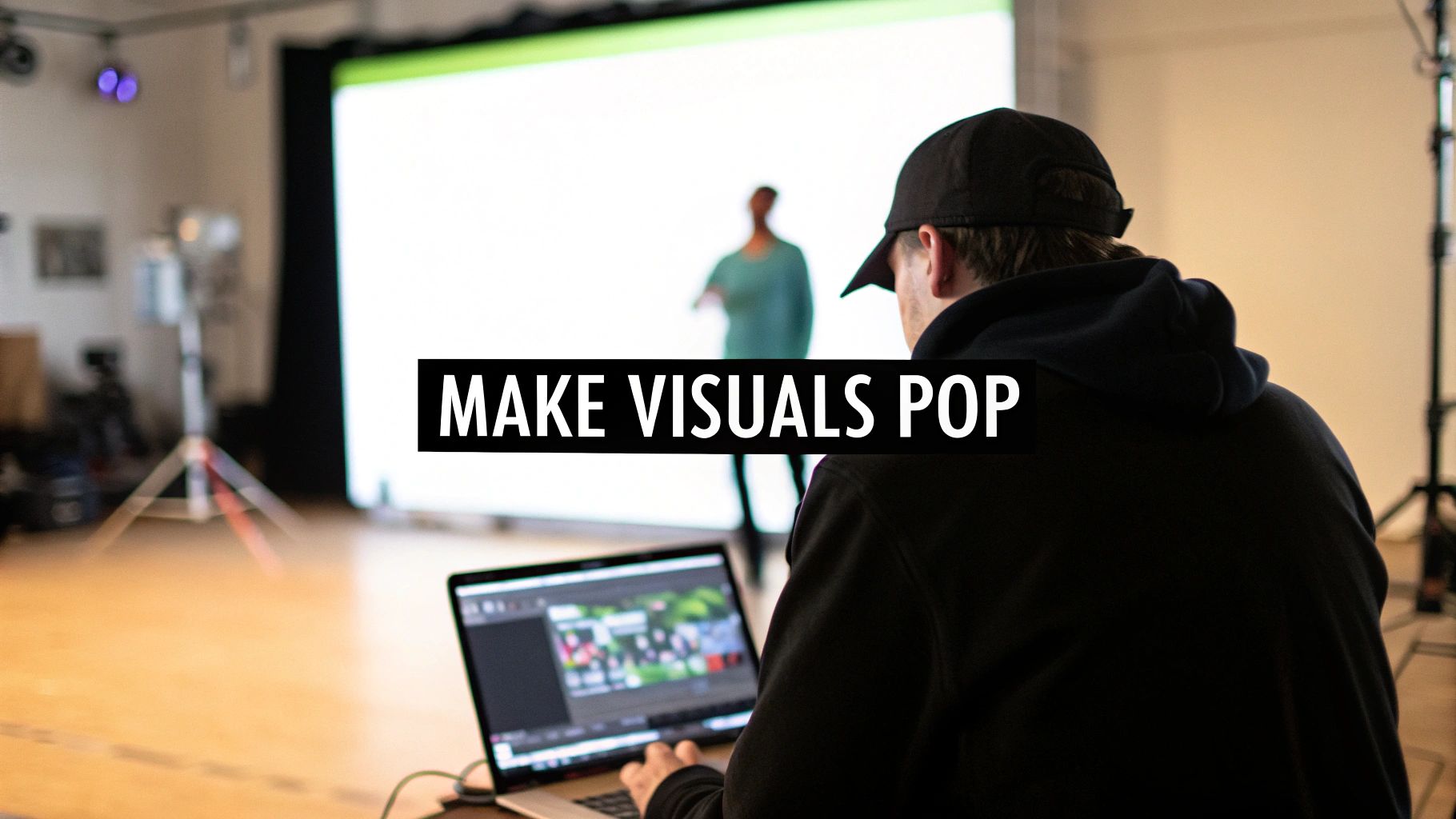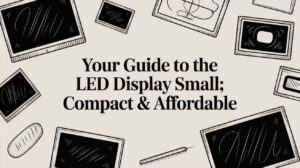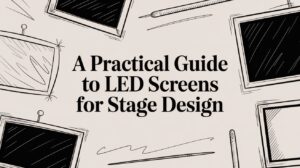
Stage with led screen: Elevate Your Event Visuals Today
Not long ago, a stage with an led screen was just a fancy backdrop. Now, it's the dynamic, beating heart of any modern live event.

Not long ago, a stage with an led screen was just a fancy backdrop. Now, it's the dynamic, beating heart of any modern live event. It transforms a static performance space into an immersive canvas, capable of showing anything from live camera feeds and abstract visuals to entire virtual worlds. It has completely changed how audiences experience concerts, corporate keynotes, and broadcasts.
Step into the world of today's event production, and you'll see that the static, painted backdrop is gone. In its place is a vibrant, digital canvas. A stage with an LED screen is now the centerpiece for creating unforgettable experiences, moving way beyond its old job of just making things on stage look bigger. Today, it’s a storytelling tool that can transport an audience to another place entirely.
This shift is about more than just a tech upgrade; it’s about creative freedom. Event designers and producers are no longer stuck with clunky physical set pieces. Instead, they can build entire environments that change, react, and evolve right along with the performance.
The advantages of building a high-quality LED wall into a stage design are impossible to ignore:
The real magic of a stage with an LED screen is its ability to create shared moments. It ensures that the person in the back row feels just as connected to the performance as the person in the front, making a massive event feel personal.
This isn't just a trend; the numbers back it up. The global LED display market, which includes screens for stages and events, hit roughly USD 8.96 billion in 2023. That's a massive 30.8% jump from 2020. This explosive growth is driven by constant improvements in the tech—better brightness, more accurate color, and wider viewing angles are all key for delivering jaw-dropping visuals. You can dig into more of these industry trends in this 2025 LED display market report.
To really get a feel for how these screens are shaking up event design, it's worth exploring the range of digital screens services available. From the first sketch to the final show, this technology is setting a new standard for what a live experience can be, which brings us to the nitty-gritty technical details we’ll cover next.
Jumping into the world of LED screens can feel a little like trying to learn a new language. You'll hear terms like “pixel pitch,” “nits,” and “refresh rate” thrown around, and it's easy to get lost in the technical jargon. But getting a handle on these key specs is what separates a good-looking stage from an absolutely jaw-dropping one.
Think of it like this: you wouldn't buy a car without knowing its horsepower or fuel efficiency. Those specs tell you exactly how it will perform on the road. It’s the same deal for an LED screen—every number and term translates directly into how sharp, bright, and smooth your visuals will look to every single person in the room.
We're going to break down the most important terms into simple, practical concepts. This way, you can talk confidently with vendors and make calls that perfectly match your creative vision and, just as importantly, your budget.
This diagram shows how a modern stage with an LED screen creates its impact by combining immersive visuals, powerful brightness, and a design that can scale to any size.

It’s a great reminder that success isn't just about one feature; it's about how captivating visuals, strong brightness, and adaptable sizing all work together.
The first spec you’ll always run into is pixel pitch. This is simply the distance, measured in millimeters (mm), from the center of one tiny LED pixel to the center of the next one. A smaller pixel pitch number means those pixels are packed tighter together.
Think of it like the thread count on a high-quality set of sheets. A higher thread count means the threads are woven closer, creating a smoother, more detailed fabric. In the same way, a lower pixel pitch (like 1.8mm or 2.6mm) packs the pixels tightly, giving you a higher resolution and a much sharper, more seamless image—especially when people are close to the screen.
This is why pixel pitch is directly tied to how far away your audience is. If someone is standing just a few feet from a screen with a big pixel pitch (say, 10mm), they’ll see the individual dots of light. The image will look blocky and pixelated. For close-up viewing, a smaller pixel pitch is an absolute must. You can get a better sense of how this plays out by exploring different indoor LED wall screen kits and seeing how they’re used in various settings.
Picking the right pixel pitch really boils down to one simple question: how close will your audience be? This chart gives you a solid starting point for making that call.
| Pixel Pitch (mm) | Minimum Viewing Distance (Meters) | Ideal Use Case |
|---|---|---|
| 1.2 – 1.9 mm | 1.2 – 1.9 meters | Boardrooms, control rooms, broadcast studios where detail is critical up close. |
| 2.5 – 3.9 mm | 2.5 – 3.9 meters | Houses of worship, auditoriums, theaters, and corporate events. |
| 4 – 6 mm | 4 – 6 meters | Larger venues, concert backdrops, and digital signage viewed from a distance. |
| 6 – 10+ mm | 6+ meters | Arenas, stadiums, and large outdoor festivals where the audience is far back. |
This isn't a hard-and-fast rule, but it's a reliable guide. It ensures your investment results in a crisp, clear image for everyone, whether they’re in the front row or the back of the house.
Next up is brightness, which we measure in a unit called nits. You don’t need to get bogged down in the science (one nit equals one candela per square meter), but just remember this: a higher nit rating means a brighter screen. This is non-negotiable for any stage production.
Stages are drenched in light—spotlights, house lights, and sometimes even sunlight pouring in. A screen that isn’t bright enough will look completely washed out and dull, and your message will get lost.
A screen's brightness is its voice in a crowded room of stage lights. If it isn't bright enough, its message—your visual content—will be drowned out and lost.
Finally, let's talk about refresh rate, measured in Hertz (Hz). This tells you how many times per second the image on the screen is completely redrawn. A higher refresh rate means the image updates more often, giving you silky-smooth motion.
For the naked eye, a standard refresh rate might look perfectly fine. But this spec becomes mission-critical the moment you bring a camera into the mix for filming or live-streaming.
Cameras "see" things differently than our eyes do. A low refresh rate can cause nasty flickering or rolling black bands to appear on the camera feed, completely ruining your broadcast. To get that clean, professional, flicker-free image for anyone watching at home, you need to look for a refresh rate of at least 3,840 Hz. This guarantees that the broadcast feed looks just as crisp and stunning as what the live audience is seeing.
Once you've got a handle on the technical specs, the real fun begins. A modern stage with an led screen is so much more than a giant TV behind the performers; it's a dynamic architectural element that can define the entire visual identity of your event or space. Thinking beyond the standard flat rectangle is where you unlock a universe of creative possibilities.
The first step is to stop thinking of the screen as an addition and start seeing it as an integral part of the stage design itself. Is it just a backdrop, or is it an immersive environment? Answering that question will guide every decision you make about its size, shape, and placement.
Figuring out the perfect screen size is a blend of art and science. It’s not about jamming in the biggest screen you can afford—it’s about finding the right screen for your venue, your audience, and your content. An oversized screen can easily overwhelm a small stage, while an undersized one will get lost in a massive arena.
Here are the key factors to weigh when you're mapping out the dimensions:

The true game-changer in modern stage design is the modular nature of LED panels. Think of them like high-tech building blocks. You can construct almost any shape imaginable, finally breaking free from the tyranny of the rectangle. This flexibility is what turns a simple stage into a jaw-dropping visual experience.
The most memorable stage designs are those where the screen and the physical set are indistinguishable. When light, video, and structure merge, you create a world for the audience to get lost in, rather than just a screen to watch.
This modularity allows for stunning configurations that can completely transform a space. For example, you could mix and match different panel types to bring a complex vision to life. You can learn more about how versatile these systems are by exploring what's possible with Smart LED indoor LED wall panels, which are built for exactly this kind of creative construction.
Of course, balancing these ambitious ideas with practical constraints like budget and rigging is crucial. A complex curved screen, for instance, will demand more specialized hardware and a longer setup time than a simple ground-supported wall.
Always start with your grandest vision, then work with your production team to find a practical solution that captures its spirit without breaking the bank. The goal is seamless integration, making your stage with an led screen a cohesive and unforgettable centerpiece.
A brilliant, high-resolution stage with an led screen is only half the battle. Behind every stunning display is a web of on-site logistics—the critical, often unseen foundation that makes sure the show runs safely and flawlessly. This is where a killer creative idea becomes a rock-solid technical reality.
Trying to skim past these details is a recipe for disaster. From calculating structural loads to planning power runs, these behind-the-scenes jobs are non-negotiable for any successful production. Let's break down the essential logistics that hold up your LED screen.
First things first: how is this giant screen going to be physically supported? There are two main ways to assemble a large LED wall, and each comes with its own set of rules for safety and looks.
And weight is the absolute biggest factor here. A large stage with an led screen can easily weigh several tons. The total load isn't just the panels; it’s the rigging hardware, cables, and processors, too. This is a job for professionals only—a miscalculation can lead to catastrophic failure.
An LED screen is a power-hungry beast. Underestimating its electrical needs is one of the most common—and expensive—mistakes in the business. A single flicker or a total blackout mid-show can kill the entire vibe of an event.
Proper power planning means bringing in a certified electrician to make sure the venue can supply enough clean, stable power. This usually means running dedicated power distribution units straight from the main electrical source, not just plugging into the wall. For big shows, this isn't optional. To give you some perspective, the iconic LED screens at AT&T Stadium can chew through around 635,000 watts during an event. This highlights just how massive the energy needs can be. You can dive deeper into LED screen energy demands in live production to see the numbers for yourself.
Just as important is ventilation. Every LED panel creates heat, and when you pack hundreds of them together, the temperature can shoot up fast.
Without proper airflow, panels can overheat. That leads to weird color shifts, components failing way too early, or even a full-on shutdown. Always leave enough space behind the screen for air to circulate, and think about using fans for bigger setups.
Your incredible visual content doesn't just magically appear on the screen. It travels through a chain of sophisticated hardware that processes the signal and tells every single pixel what to do. Two key players make this happen.
Getting these logistical pillars—rigging, power, and signal flow—right is what separates the amateurs from the pros. It’s the technical discipline that ensures your creative vision for a stage with an led screen comes to life without a single hitch.
Your LED screen is a powerful canvas; now it’s time to become the artist. Even the most technically perfect stage with an led screen will fall flat without compelling content driving the experience. This is where your creative strategy has to meet technical execution, turning a blank slate of pixels into a core part of the show.
The content creation workflow is a journey that begins long before the audience ever arrives. It kicks off with the initial concept—what story are you trying to tell?—and moves through design, animation, and rendering before finally getting loaded into a media server for live playback. Every single step is critical if you want a seamless visual performance.

The first rule of creating content for an LED screen is simple: respect its native resolution. Unlike a projector where you have a little wiggle room, an LED wall has a fixed number of physical pixels. Creating your video content at that exact resolution—say, 3840 x 1080 for a wide screen—is non-negotiable.
If you don't match the resolution, you force the video processor to scale your content, which almost always results in a soft, blurry, or distorted image. It’s like trying to print a low-resolution photo on a giant poster; all the flaws become painfully obvious.
Another crucial concept is the safe zone. Think of this as the central area of your screen where all the critical information, like text or a presenter’s face, should live. Because audience members on the far sides of a venue might have an obstructed view of the screen's edges, keeping key elements centered guarantees everyone sees what truly matters.
"A common mistake is designing content edge-to-edge as if it were for a website. On a live stage, sightlines are everything. A well-designed safe zone ensures your message lands with every seat in the house, not just the ones in the middle."
To really grab your audience and make sure your message hits home, you need to explore innovative presentation designs that are amplified by these huge screens. You can find some fantastic inspiration from resources that offer Top Presentation Design Ideas to Captivate, helping you craft visuals that are both stunning and effective.
LED screens have some unique characteristics you can use to your advantage. Their ability to produce incredibly deep blacks and vibrant, saturated colors makes them absolutely perfect for high-contrast visuals.
Finally, whatever you do, don't wait until show day to see your content on the screen for the first time. Pre-visualization software lets you simulate the stage and screen in a 3D environment, helping you spot issues with timing, composition, and aspect ratio way ahead of time.
On-site testing is just as important. This is your chance to check colors under the actual stage lighting and make sure every video clip plays back without a single stutter. This final check is what helps you avoid those disastrous on-air mistakes, ensuring the visual experience for your stage with an led screen is as flawless as you envisioned.
Alright, let's talk about the numbers. When you're thinking about a high-impact stage with an led screen, it's easy to focus on the cost of the panels themselves. But the real picture involves a lot more—from the tech that drives it to the skilled hands that bring it all to life.
The final price tag hinges on a few big variables. The most obvious are the screen’s size and pixel pitch. It's simple: a bigger, sharper screen is a bigger investment. But don't overlook things like custom rigging, power distribution, and how complex the setup is. These all play a huge part in the total cost.
As you start mapping out your budget, make sure these critical pieces are on your radar:
So, how do you make the case that a major investment in a stage with an led screen is actually worth it? The return on investment (ROI) here is about so much more than just looking cool. It’s about creating real, measurable value that can hit your bottom line and completely transform the event experience.
You can see this value reflected in the booming rental market. In fact, the stage rental sector for LED displays is growing at a clip of over 15% every year. That growth is all about the demand for dynamic, high-def visuals at events where grabbing and holding attention is everything. You can dig into these LED display market research trends to see just how fast the industry is moving.
The true value of an LED screen isn’t just in the pixels. It’s in the opportunities it unlocks. It’s a powerful platform for sponsors, a magnet for social media, and a serious tool for driving ticket sales.
This investment pays you back in tangible ways. For corporate events and trade shows, eye-catching visuals can dramatically boost booth traffic and lead generation. It’s a principle many companies have discovered by exploring the benefits of LED signs for businesses to make their brand impossible to ignore.
Here’s a breakdown of how a top-tier LED display pays for itself:
Of course. Here is the rewritten section, crafted to sound completely human-written and natural, following the style of the provided examples.
When you start planning a show with a big LED screen, a few practical questions always pop up. Trust me, you want to get these sorted out early. Nailing down the answers will save you from some serious headaches and costly mistakes down the line, ensuring your visuals are killer from day one. Let’s jump into the most common ones.
Short answer: Please don't. It’s a huge risk and almost always a bad idea.
Outdoor screens are built completely differently. They need to be incredibly bright—we’re talking 5,000 nits or more—just to compete with direct sunlight. An indoor screen, even a good one, will look completely washed out and faded the second the sun hits it.
Even more critical is the weather. Outdoor panels are IP-rated, meaning they’re sealed to protect the sensitive electronics from rain, humidity, and dust. An indoor screen has zero protection against the elements. A little bit of moisture can permanently fry it, turning your investment into a very expensive paperweight. It’s a classic case of using the right tool for the job.
This is a great question, and it's where a lot of people get tripped up. They sound similar, but they do two very different jobs.
Think of the video processor as the screen's technical brain. Its one and only job is to take whatever video signal you feed it and scale it perfectly to fit the screen's exact pixel dimensions. Without it, the image just won't look right.
The media server, on the other hand, is the creative beast. It's a high-powered computer designed to store, play back, and manipulate complex video files in real time.
You absolutely need a processor to make any stage with an LED screen work, period. But you need a powerful media server when you’re running a dynamic show with multiple video layers, live effects, and complex visual cues that need to be triggered on the fly.
For the vast majority of people and events, renting is the way to go. It’s smarter and way more cost-effective.
When you rent, you get access to the latest and greatest technology for each specific project, without the massive upfront cost of buying. Ownership comes with a ton of hidden expenses, too—maintenance, specialized storage, and insurance all add up fast.
Buying only really makes sense for permanent installations where the screen is being used constantly. Think houses of worship, nightclubs, or broadcast studios. For tours, festivals, and corporate events, renting gives you all the impact with none of the long-term headaches. It’s the industry standard for a reason.

Not long ago, a stage with an led screen was just a fancy backdrop. Now, it's the dynamic, beating heart of any modern live event.

Forget massive stadium jumbotrons for a moment. When we talk about a small LED display, we’re not necessarily talking about its physical dimensions. Instead, we’re

LED screens on stage aren't just backdrops anymore—they're the pulsing, dynamic heart of today's live events. These huge digital canvases are designed to be insanely
"*" indicates required fields